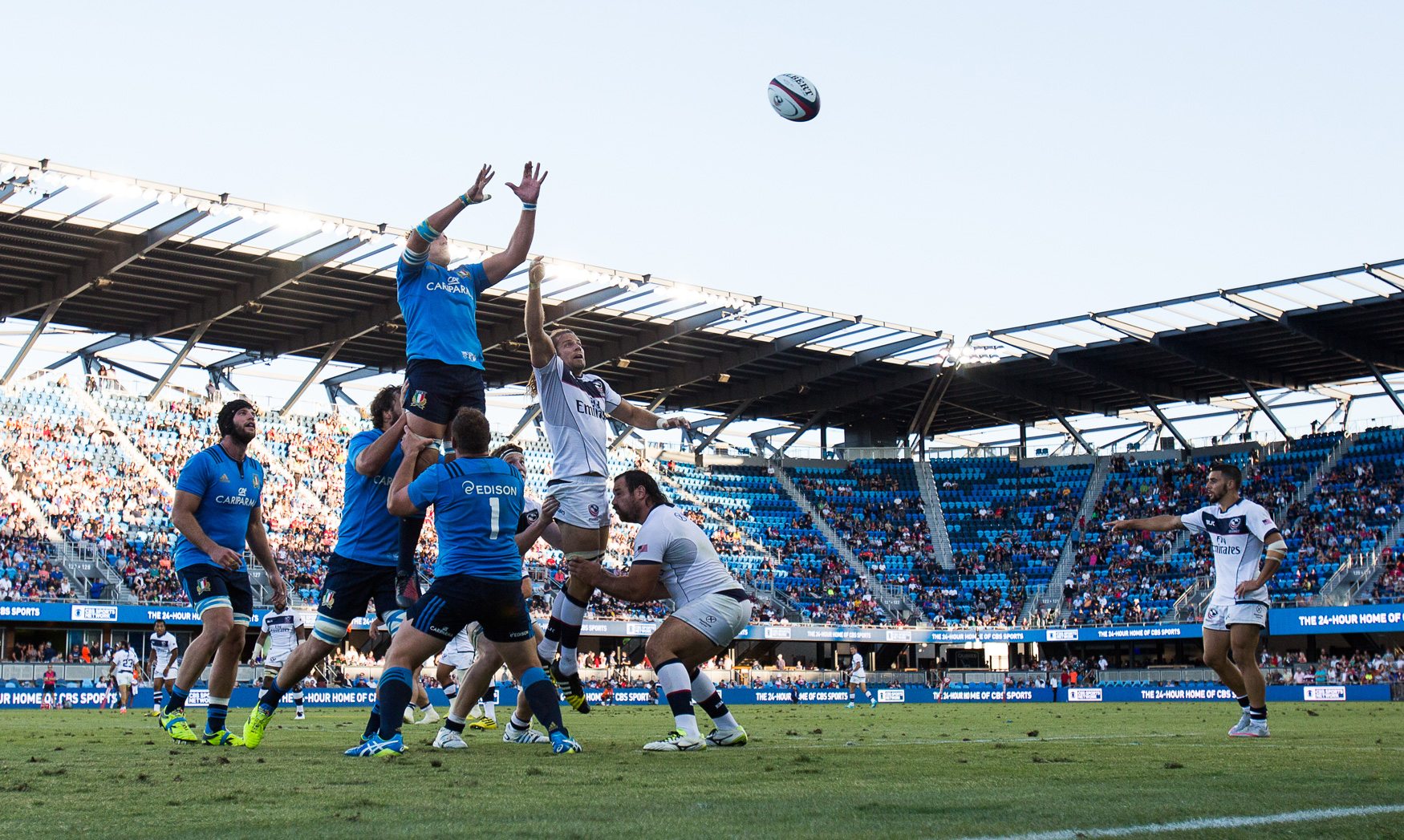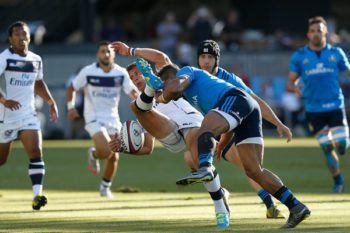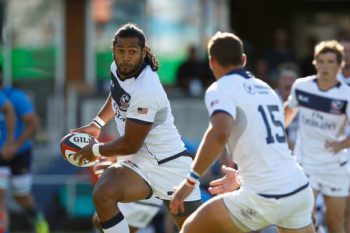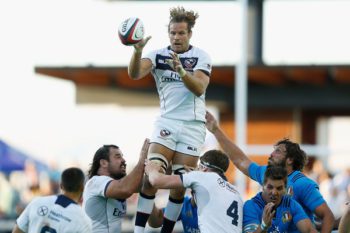
 SAN JOSE, CA – The USA Eagles fell 20-24 to the Azzurri of Italy on Saturday night but it was one of the more exciting – yet frustrating – contests the Eagles have had with a Tier 1 side. Despite a host of problems, the USA continued to strive and had the advantage in the final 20 minutes. That alone is a huge step up from past performances and deserves praise. Luck is always a factor at the end of close games and the Americans were in the fight until the end… just failing to capitalize on a few key chances.
SAN JOSE, CA – The USA Eagles fell 20-24 to the Azzurri of Italy on Saturday night but it was one of the more exciting – yet frustrating – contests the Eagles have had with a Tier 1 side. Despite a host of problems, the USA continued to strive and had the advantage in the final 20 minutes. That alone is a huge step up from past performances and deserves praise. Luck is always a factor at the end of close games and the Americans were in the fight until the end… just failing to capitalize on a few key chances.
Before anyone gets too excited, I need to mention the excuses: Italy came off a long travel schedule, missed some of their most famous players (but it could be argued oldest does not equal best) and lost one of their best attacking players in the first 4 minutes (along with, arguably, the Eagles’ best attacking player).
Coach John Mitchell talks often about earning or deserving a T1 scalp to imply winning is not just about a few lucky bounces, but requires the fitness, fundamentals, and skills to contest for 80 minutes. Did the US deserve a victory on Saturday? I would say no, but they certainly earned the score line and deserved their 1 point deficit heading into the final 10 minutes.
The goal here is not to recap the game in full or analyze the angle of people’s hips in scrums. I will expand on some of the areas where the US performed exceptionally as well as parts of the game that were disappointing. This includes players, phases of play and general aspects of the game.

Highlights
AJ MacGinty
Let’s get my one criticism out of the way first: his clearance kicking was a bit weak and maybe that’s nerves – or just that he doesn’t have a huge boot; Connacht spent the year attacking from within their 22. MacGinty carried the team throughout the match. He was an exciting player last summer, but anyone watching his development at Connacht has seen him become one of the premier 10s in professional rugby. Watching this match just reiterated that: perfect with his kicks, aggressive in defense (including one steal worthy of a back row player), and creating plays for the backline. After a year of professional rugby, his confidence and speed of decision making are the biggest changes. I just hope his trajectory continues upward.
Fitness

Thank God this is in the highlights category! Considering that Mitchell brought up fitness in every other sentence of every interview since last November, seeing a let down in the final 20 minutes would have been embarrassing. The biggest team-wide highlight was the improved fitness as the whole squad still fought through the final 10 or 20 minutes of the match and arguably looked like the stronger team at that point. Credit to Mitchell and Chris Brown, formerly the Eagles 7s fitness coach, now the assistant coach of the 7s program and in charge of fitness for both 7s and 15s. Mitchell’s emphasis here as well as the Eagles Elite Training Squad (EETS) structure and the broader coaching and high performance staff (including the 7s program).
Before the test, there were some questions about certain selection decisions in terms of the player pool and the roster for this test. But after watching the performance, there should be at least grudging respect for those choices. Even if some players were not as physically imposing as alternatives or not fully comfortable in international test rugby, everyone (or at least most) had the fitness to play to their capability for the full 80. And in some ways, that may be more important.
Backline Play
The success of the back line is linked to the first two points. MacGinty consistently organized solid attacking lines and the backs had the fitness to maintain the pace. There were certainly periods of spotty play or questionable decisions, but any time the US started to get a bit of go-forward ball the backs rolled through the phases making “dynamic” plays. This is a huge difference from the Eagles last year where, other than a handful of big line breaks, the backs never looked particularly dangerous. A lot of crash balls for 1-2 meters or wide balls for negative 10 meters. If the Eagles can establish a more attacking form of back play that actually generates tries, I predict some scalps in the next few years.

Depth
This is a bit of a fuzzy one. There is still a big gap at certain positions between first choice and second choice players. Often this is when its between a pro and amateur option. That gap seems to be shrinking and could be highlighted by the injuries the US suffered in the first half. Despite losing Greg Peterson and Takudzwa “Z” Ngwenya early, their subs in Lamborn and Teo both stepped up and were responsible for key plays throughout the game.
Looking at the big tests last weekend in England v Australia and Ireland v South Africa, it is quite clear how important those substitutes can be for a team. Winning at that level requires having a bench that is arguably as good as your starting 15 (or in the case of SA, maybe better) and that can come on fresh and bring a renewed intensity. Joe Taufete’e certainly did that while Tom Lamborn and Mikey Te’o were excellent for the entire test. Having those kinds of players on the bench is one factor in finishing strongly in tight contests. I called this a fuzzy highlight because its not totally clear how great the depth was across the full bench. And actually, the fitness of the starting 15 meant it was not quite tested.

7s
The success of the 7s program in emphasizing fitness and developing fundamentals is impressive. Of course the guys coming straight from 7s looked a bit out of place at times or not always making the right decisions. It could be added as a lowlight as well but considering limited time to adjust, all the 7s and ex-7s players did well enough. And everyone that came through the OTC has demonstrated the fitness, tackling, and attacking mentality needed to compete at this level.
Thretton Palamo was a better player than a year ago (and was still an attacking threat late in the game). Will Holder was surprisingly comfortable at 15 with a couple great runs. Augsperger was a bit maddening despite having a great debut overall. In fast attacking play, he looked like a world class scrum half. He also showed off his pace and sure tackling, but in more complex situations or messy rucks, he did not look comfortable in the role yet.

Lowlights
Pace of Play
The most obvious gap for the Eagles compared with Tier 1 sides is in their ability to handle the pace and intensity of an international test. When things start moving quickly or there is a highly contested breakdown, the players playing professionally overseas (sorry PRO Rugby) look far more comfortable reacting quickly and making good decisions. AJ was a good example of this. The speed of his decision making or reaction time is vastly improved compared with what he accomplished last year (which was still impressive). Others made some costly mistakes in the heat of the moment, holding on too long in rucks, or making desperate attempts to contest the ball. The hope here is that as PRO becomes a bigger feeder for the Eagles and the quality rises, everyone will be more capable of handling this level of intensity.
Situational Awareness
Similar to the previous lowlight, which could be described as responding to the pace of play of their opponents. Situational awareness is about the ability for all the Eagles to play at the pace they choose to set. Basically, there were way too many silly mistakes that came from guys playing too fast or expecting to be able to pull off moves that may work at lower levels but aren’t going to work here. Certain players were not as comfortable either playing 15s or playing at this level. Nate Augsperger, for all his successes, clearly struggled with what to do at times from behind the ruck.

There were a few situations that stood out through 80 minutes where the US had a “sudden possession.” Stealing a lineout, recovering an up-and-under, or charging down a kick (I don’t really count ruck turnovers since they aren’t so sudden and usually just turn into a penalty or at least a slow ball). Every time the US had one of these counter-attack opportunities, the ball was lost via some of the worst possible choices.
Failures of Quick Decisions
- At 5 minutes, Peterson manhandles a ball out of an Azzurri maul off their lineout– Todd Clever immediately throws the ball into touch. I blame that one of Clever. Augsperger was in good position, but no one really saw that ball come out. And Clever’s quick pass was just too quick. If Augsperger had tried to sneak down that blindside off the lineout, I feel like this play still would have made the list with Augsperger getting tackled into touch.
- Teo recovers a high kick beautifully in the attacking half–Teo immediately throws a high risk offload. Again, it seemed like the sudden success bred a sort of greed to turn the play into a miraculous score. When just taking contact and setting up attacking play close to the 22 would have been fine.
- Augsperger charges down a clearance kick–Half the forward pack gets convinced they can recover the ball and just leap into a pile all on the floor. Any chance of recovering that ball died once the second or third guy dove in, essentially pinning everyone in the ruck illegally. Italy got to clear via a penalty kick, worse for the US than if Augsperger had never charged it down. Mitchell mentioned in the post-game that Italy were off their feet too. A little more restraint by the Eagles joining the fray may have demonstrated to the referee that Italy deserved the penalty.
- Brakeley steals a lineout while down by 1 point in the closing minutes–The forwards go into a hopeless maul. This was the most frustrating because after the steal, nothing good happened. Nate Brakeley went forward towards the lineout with everyone piling in to create an obviously unwinnable maul. A pop out to Augsperger or a pass back to another forward could have given the Eagles a chance to attack in the closing minutes. I think that was the only clean lineout steal by the Eagles and they did not seem ready to handle it.

Set Pieces
I guess no one should be too surprised considering the history against Italy or really any Tier 1 pack, but the scrums and lineouts were the biggest let down and allowed Italy to grind out the win. Was I the only one that had a brief moment of hope in that second scrum? For about 3 seconds, it looked like the US could hold on, but the sustained pressure from Italy was too much. Although other penalties played a part and the US won their share of scrums and lineouts, the most obvious reason Italy was able to stay ahead of the Eagles was the consistent ability to draw scrum penalties in attack and then achieve dominating mauls off of lineouts.
The scrummaging did seem slightly better compared with past problems as most scrums did not seem hopeless. Losing Peterson early also had an impact in both lineouts and scrums. While the plan was probably for Brakeley and Cam Dolan to finish out the game at lock (with two pure loose forwards on the bench), that was supposed to happen in the final ~20 minutes when the Azzurri would be gassed. At that point, the two high-fitness lower weight locks could potentially be an advantage. Instead, the entire game was played with a somewhat undersized lock pairing.
In the front row, Chris Baumann made a valiant effort but looked outmatched by Italy while James Hilterbrand also could have been somewhat under-powered. I don’t pretend to fully understand what goes on in the front row, but Taufetee came on right before a scrum where Italy went for another scrum penalty and failed. Maybe a coincidence, but he does seem like a more powerful option at hooker.

For next week, hopefully more time together will mean the lineout jumpers are better in tune with Hilterbrand or Taufetee. Taufetee is always described as more of a ball carrier, yet had one of the few breakdown steals for the Eagles in the match along with Lamborn and oddly enough MacGinty.
Longer term, the hope is Peterson and Samu Manoa will be available in November forming a more powerful lock pairing (or at least providing the option). Technique and repetitions against high quality competition are important for the Eagles development, but I have always been of the somewhat cynical view that the physical capabilities required are largely innate (strength, size, etc) and no matter the coaching and experience, it starts from having a group of forwards physically capable of competing. I think this group is closer to that capability now and hopefully it is just about putting the final pieces together.
Going Forward
Overall, there are more highlights than lowlights and a few of those highlights, like the fitness, are significant improvements over past Eagles squads. The lowlights do sound like a bit of a broken record, but there were also aspects of each that should give us a sense of hope. Considering this is the start of a new four year cycle, I am cautiously optimistic that the Eagles are heading in the right direction along a path towards “big things”. How long that path may take is still an open question.
Feel free to comment below, look for and “Like” our Facebook Rugby Wrap Up Page and follow us on Twitter@: RugbyWrapUp, Junoir Blaber, @MeetTheMatts, Luke Bienstock, Ronan Nelson, Crawford Miller, James Harrington and Declan Yeat

